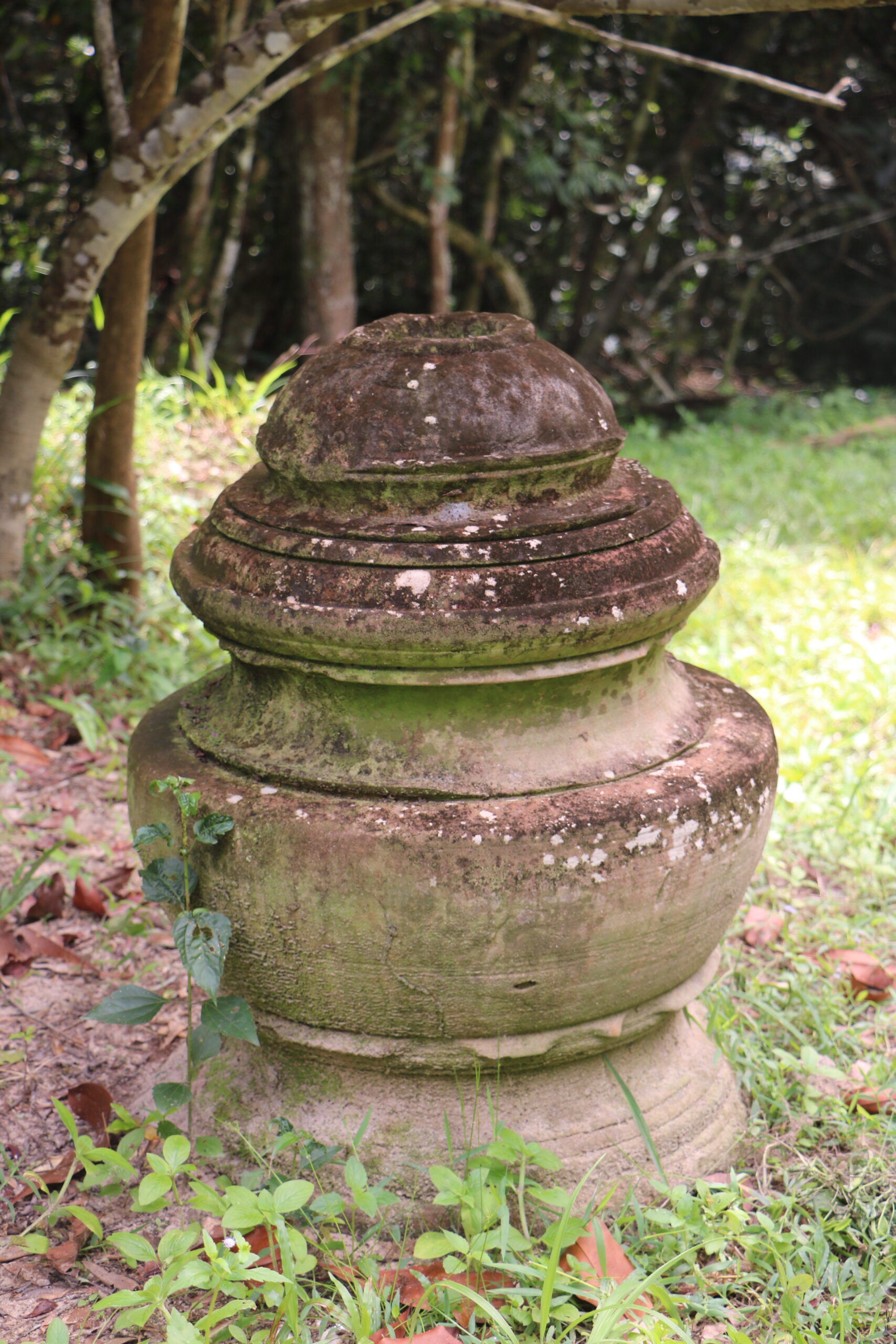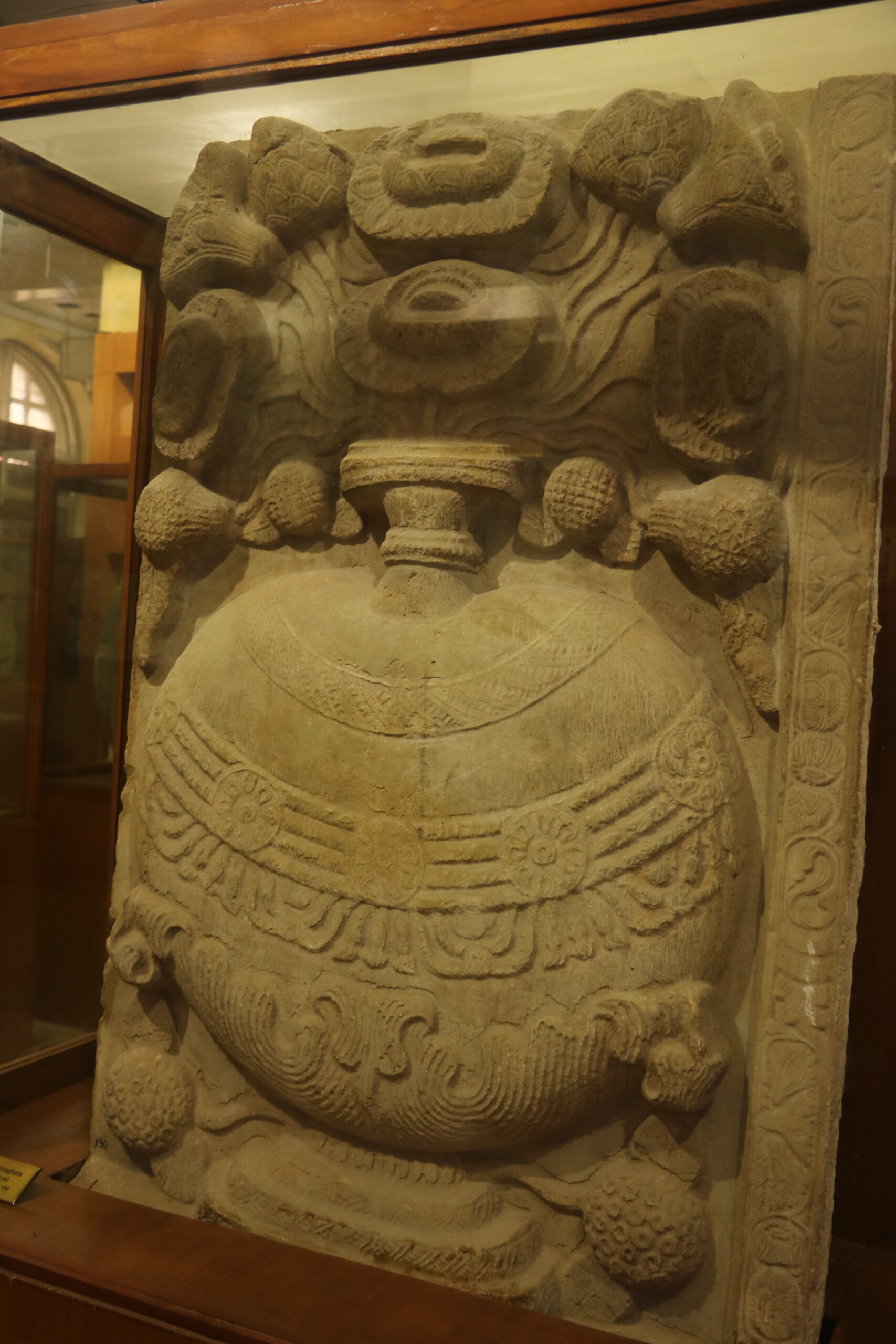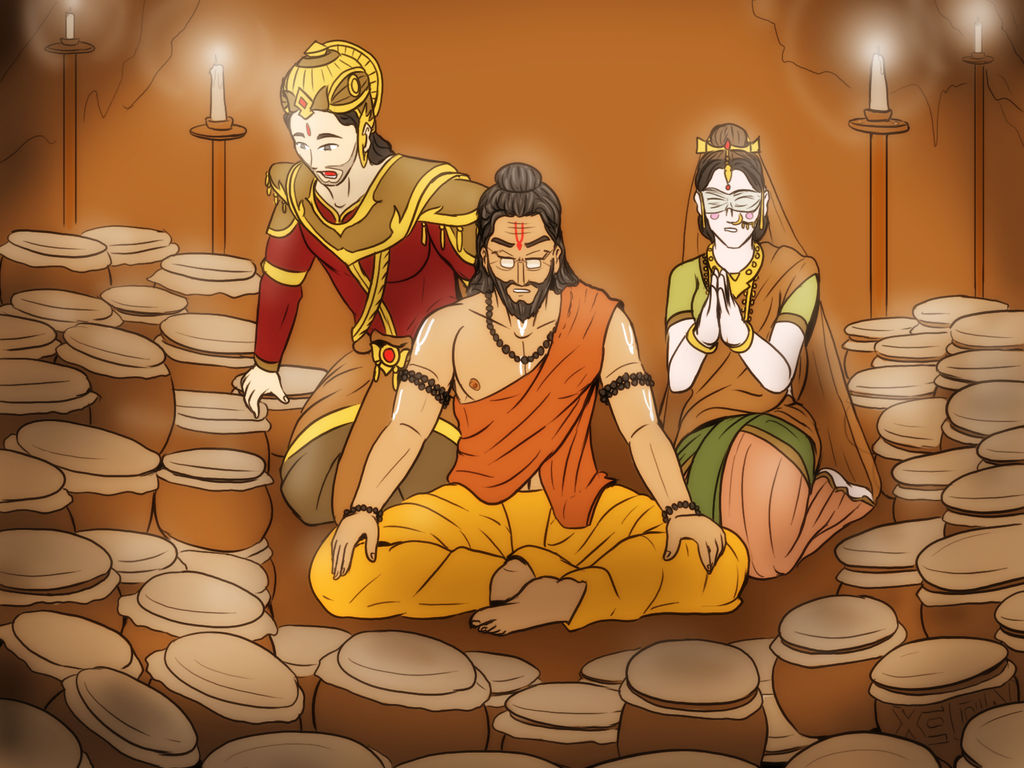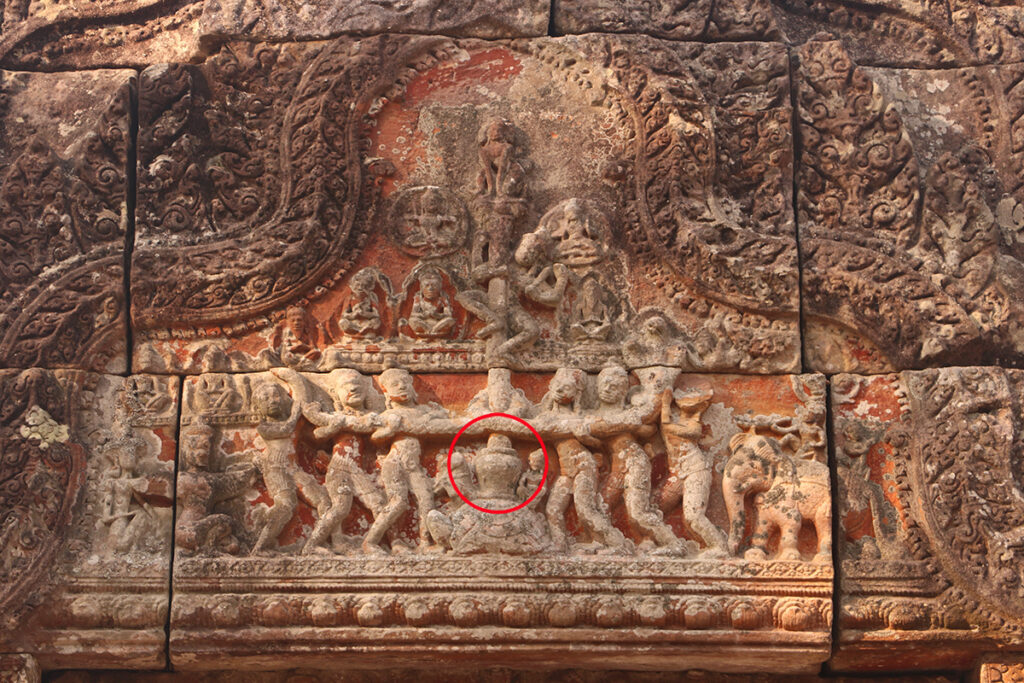កលឝ (Kalaśa) ជាភាសាសំស្ក្រឹតសំដៅដល់ភាជន៍មួយប្រភេទដែលពេលខ្លះមានសណ្ឋានស្រដៀងនឹងថូទឹក តែពេលខ្លះក៏មានសណ្ឋានជាឆ្នាំងឬក្អមដែរ។ សព្វថ្ងៃនេះពាក្យ កលឝ នេះបានក្លាយមកជាពាក្យខ្មែរបច្ចុប្បន្នថា “ក្លស់”។ កលឝ ជានិមិត្តរូបមង្គលមួយប្រភេទដែលមានការរាប់អានខ្លាំងនៅក្នុងសង្គមវប្បធម៌ឥណ្ឌា ដោយយើងអាចមើលឃើញនៅតាមសំណង់ប្រាសាទនានារបស់ឥណ្ឌាតែងមានការលម្អកលឝនេះជានិច្ច ឬតាមពិធីផ្សេងៗរបស់ឥណ្ឌាក៏មានប្រើកលឝនេះដែរ។ ដោយឡែកក្នុងសង្គមខ្មែរនៅសម័យបុរាណដែលបានទទួលយកឥទ្ធិពលវប្បធម៌យ៉ាងច្រើនពីឥណ្ឌាវិញ ក៏បានទទួលយកគំនិតនៃការប្រើប្រាសកលឝជានិមិត្តរូបមង្គលសម្រាប់យកមកលម្អនៅតាមប្រាសាទខ្មែរផងដែរ។


ជាទូទៅកលឝ ដំណាងឱ្យភាពសម្បូរសប្បាយ ភោគផល កំណើត និងកម្លាំងជីវិតដែលពោរពេញដោយថាមពល។ហេតុផលមួយដែលបង្ហាញថាកលឝតំណាងឱ្យភាពសម្បូរសប្បាយឬភោគផល មានការពន្យល់ថា កលឝជាភាជន៍មួយប្រភេទដែលអាចទាំងដាក់ទឹកបានផង និងអាចទាំងដាក់ដីបានផង ដូចនេះគេអាចដាំដើមរុក្ខជាតិនៅខាងក្នុងនោះបាន។ រុក្ខជាតិនោះទៀតសោធក៏មានចេញផ្លែផ្កាពេញដើម ដែលនេះជានិមិត្តនៃភោគផលនិងភាពសម្បូរសម្បាយ។ កលឝដែលមានរុក្ខជាតិដុះចេញមកនោះ នៅក្នុងសិល្បៈឥណ្ឌាគេហៅថា បូរណកលឝ (Pūrṇa Kalaśa) ឬបូរណកុម្ភ (Pūrṇa Kumbha) ឬបូរណឃាត (Pūrṇa Ghạta)។

ចំពោះគំនិតដែលបង្ហាញថា កលឝតំណាងឱ្យកំណើតនោះយើងអាចឃើញច្បាស់អំពីគំនិតនេះនៅក្នុងរឿងមហាភារតៈត្រង់ឈុតការឱ្យកំណើតបុទ្រទាំង១០១របស់ព្រះនាងគន្ធារី។ រឿងនេះដំណាលថា កាលគ្រាមួយព្រះនាងគន្ធារីដែលជាមហេសីរបស់ស្ដេចធឫតរាស្ត្រ បានទទួលពរពីឫសីវ្យាសៈថាឱ្យព្រះនាងមានបុត្រាចំនួន១០០។ ក្រោមមកព្រះនាងទ្រង់គភ៌បុត្ររហូតដល់ទៅ២ឆ្នាំ ហើយនៅទីបំផុតទ្រង់ប្រសូតបានជាដុំសាច់មួយដុំធំទៅវិញ។ ព្រះនាងបានទៅតវ៉ាឫសីវ្យាសៈអំពីពរដែលឫសីឱ្យព្រះនាង ជាលទ្ធផលឫសីវ្យាសៈបានបង្គាប់ឱ្យគេយកដុំសាច់នោះមកកាត់ជា១០០ចំណែក ហើយយកទៅដាក់ក្នុងឆ្នាំងដើម្បីធ្វើឱ្យសាច់ទាំងនោះក្លាយជាទារក។ គ្រានោះព្រះនាងគន្ធារីក៏សូមអង្វរឱ្យឫសីជួយឱ្យទ្រង់មានបុត្រីមួយអង្គបន្ថែមទៀត ទើបឫសីវ្យាសៈបានបំបែកសាច់មួយដុំផ្សេងទៀតទៅក្នុងឆ្នាំងទី១០១ដើម្បីធ្វើឱ្យបានទៅជាបុត្រី។ នៅទីបំផុតសាច់ទាំង១០១ដុំនោះក៏បានក្លាយជាទារកហើយកើតចេញមកដែលគេស្គាល់ថាជាបងប្អូនកោរវៈ។ ក្នុងករណីនេះបង្ហាញថាឆ្នាំងទាំងនោះ បានធ្វើនាទីជំនួសឱ្យគភ៌មាតាដែលឱ្យកំណើតបុត្រនោះឯង។

ចំពោះគំនិតមួយដែលថាកលឝមានទំនាក់ទំនងទៅនឹងកម្លាំងជីវិតដែលពោរពេញដោយថាមពល ឬសេចក្ដីអមតៈ យើងអាចឃើញបានយ៉ាងច្បាស់នៅក្នុងទេវកថារឿងកូរសមុទ្រទឹកដោះរបស់ពួកទេវនិងអសុរ។ គោលបំណងសំខាន់នៃការកូរសមុទ្រទឹកដោះនេះគឺដើម្បីបានទឹកអម្ឫតដែលធ្វើឱ្យមានមហិទ្ធិឫទ្ធិនិងជីវិតអមតៈ ហើយការលេចឡើងរបស់ទឹកអម្ឫតនេះទៀតសោកក៏កើតចេញក្នុងរូបភាពជារូបថូទឹកឬឆ្នាំងដែលជាកលឝផងដែរ។ ដោយហេតុថា កលឝជាឧបករណ៍សម្រាប់ដាក់ទឹកអម្ឫតនេះហើយ ទើបធ្វើឱ្យកលឝក៏ក្លាយជានិមិត្តរូបនៃកម្លាំងជីវិតដែលពោរពេញដោយថាមពល និងជីវិតអមតដែរ។

ដោយហេតុថាកលឝជានិមិត្តរូបនៃភាពសម្បូរសប្បាយ ភោគផល កំណើត និងកម្លាំងជីវិតដែលពោរពេញដោយថាមពល ដែលសុទ្ធសឹងតែជារឿងមង្គលបែបនេះហើយ ទើបរូបកលឝបានក្លាយជារបស់សំខាន់មួយដែលគេនាំយកទៅលម្អនៅតាមប្រាសាទស្ទើរតែគ្រប់ផ្នែកទាំងអស់នៃប្រាសាទខ្មែរ៕
———————————-
Kalaśa in Khmer Architecture (Part 1)
Kalaśa in Sanskrit word refers to a type of ceramic that is sometimes shaped as a vase but sometimes in the form of a pot or clay pot. Today, the word Kalaśa has become the current Khmer word “Klaśa”. It is a symbol of happiness that is very popular in Indian cultural society, as we can see in the temples of India, this is always decorated the Kalaśa or in Indian ceremonies are also used Kalaśa. In particular, in ancient Khmer society, which received a lot of cultural influence from India, also accepted the idea of using the Kalaśa as a symbol of happiness for decoration in Khmer temples.
Kalaśa generally represents abundance, fruitfulness, birth, and energetic life force. One of the reasons that Kalaśa represents abundance or yield is explained that Kalaśa is a type of pot that can both hold water and soil, so they can grow plants inside. The plant also grows full fruit and flowers, which is a symbol of fruitfulness and abundance. In Indian art, Kalaśa containing plant growth is called Pūrṇa Kalaśa or Pūrṇa Kumbha or Pūrṇa Ghạta.
As for the idea that Kalaśa represents birth, we can clearly see this idea in the story of Mahabharata in the scene of giving birth to 101 children of Kuntheary. This story depicts that one upon a time when Princess Kuntheary, the wife of the Dhritarāshtra king received a blessing from Vyāsa that she had 100 sons. Later, she became pregnant for two years and eventually gave birth to a large tumor. She went to complain to Vyāsa about the blessings that Vyāsa gave her. As a result, Vyāsa ordered the tumor to be cut into 100 pieces and put in a pot to turn the tumor into a baby. At that time, Princess Kuntheary also begged Vyāsa to help her have one more daughter, so Vyāsa cut another piece of tumor into the 101 and put it in the pot to become a daughter. Eventually, the 101 pieces of tumor became babies and were born, known as the Kaurava brothers. In this case, it appears that the pots acted as a substitute for the mother giving birth to the child.
The idea that Kalaśa is related to a life force, full of energy or immortality, can be clearly seen in the myth of the churning of the sea of milk in the ever-continuing struggle between the devas (gods) and the asuras (demons). The main purpose of the churning of the sea of milk is to release amrita, which gives great power and immortality, and the appearance of amrita also appears in the form of a vase or a pot that is Kalaśa. Otherwise, Kalaśa is an object for placing amrita, which is becoming a symbol of life force, full of energy and immortality.
As the Kalaśa is a symbol of abundance, fruitfulness, birth, and life force full of energy, which is all such happiness, thus, the Kalaśa has become an important object that is brought to decorate almost every temple and all parts of Khmer temples.
អត្ថបទដោយ៖ លោក ឡេង ស៊ីរ៉ង់






